G7 fortress summit keeps protesters—and reality—at a safe distance
My dispatch from the designated demonstration zones at the Kananaskis G7.
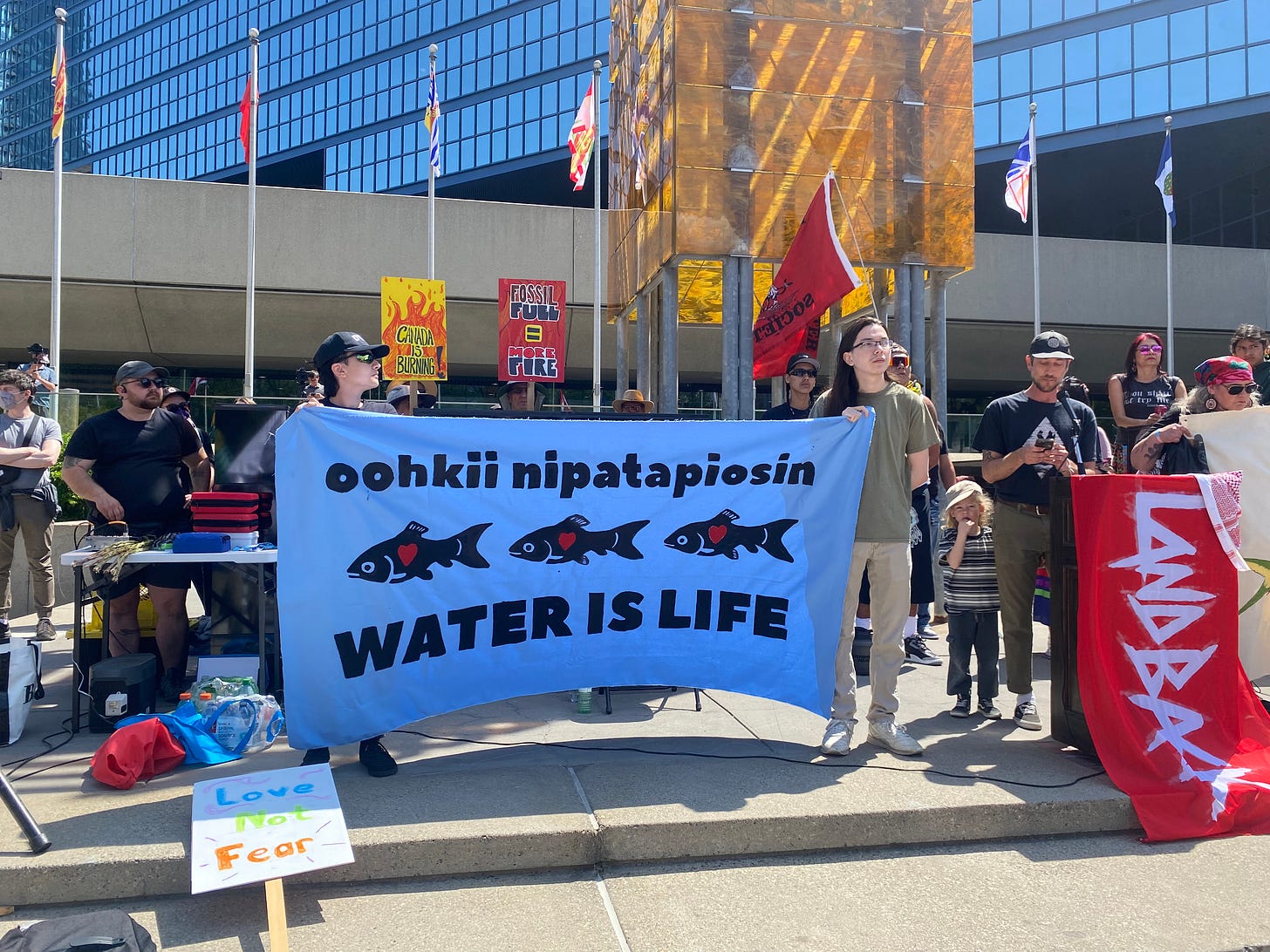
Kananaskis served as a fortress from June 15 to 17, sheltering world leaders from popular discontent over climate catastrophe, the genocide in Gaza, Indigenous rights, the exploitation of migrant workers and other issues that are a direct result of their failed policies.
In the weeks leading up to the G7 summit, the RCMP announced four “designated demonstration zones,” or DDZs, outside the Kananaskis district limits, which police naturally portrayed as a means of protecting the “safety of the protestors and general public.”
There were three dystopian DDZs in Calgary—outside city hall, near the Stampede grounds and a special viewing area outside the Calgary International Airport—and one in Banff—the Fenlands Banff Recreation Centre just outside the town limits.
"Creating these locations ensures minimal disruption to critical infrastructure such as roads or highways,” RCMP chief superintendent David Hall said, as if disrupting business as usual wasn’t precisely the point of mass protest.
Calgary, by the way, is 86 km from Kananaskis and Banff is 46 km away from the summit site.
By contrast, the last time the G7 was held in Canada, the Council of Canadians was irked that the designated democracy zone was 2 km from the Fairmont Le Manoir Richelieu in Charlevoix, Quebec.
The Mounties promised that each DDZ, save for the one at the Calgary airport, “will be equipped with infrastructure to broadcast demonstrators' messages to G7 Leaders and delegations in Kananaskis.”
Beyond a sign outside Calgary city hall to that effect and the surveillance drones buzzing overhead, I saw no indication that there was any livestream from the DDZs to the summit.
And besides, even if there was some sort of live feed for the world leaders, would any of them bother listening?
The entire purpose of hosting the G7 in Kananaskis is so that the most powerful people in the world don’t have to listen to the plebs, as was the case the last time it was held there in 2002.
Prior to the summit’s Sunday kickoff, there were two pieces of counter-programming that attempted to set the tone for the weekend.
The first was an art installation that activist groups Calgary Climate Hub, Indigenous Climate Action and Common Horizon set up at the Confluence (formerly known as Fort Calgary), which consisted of lettering on grass reading: G7 Pick a Path: Pipelines [or] Climate Action.
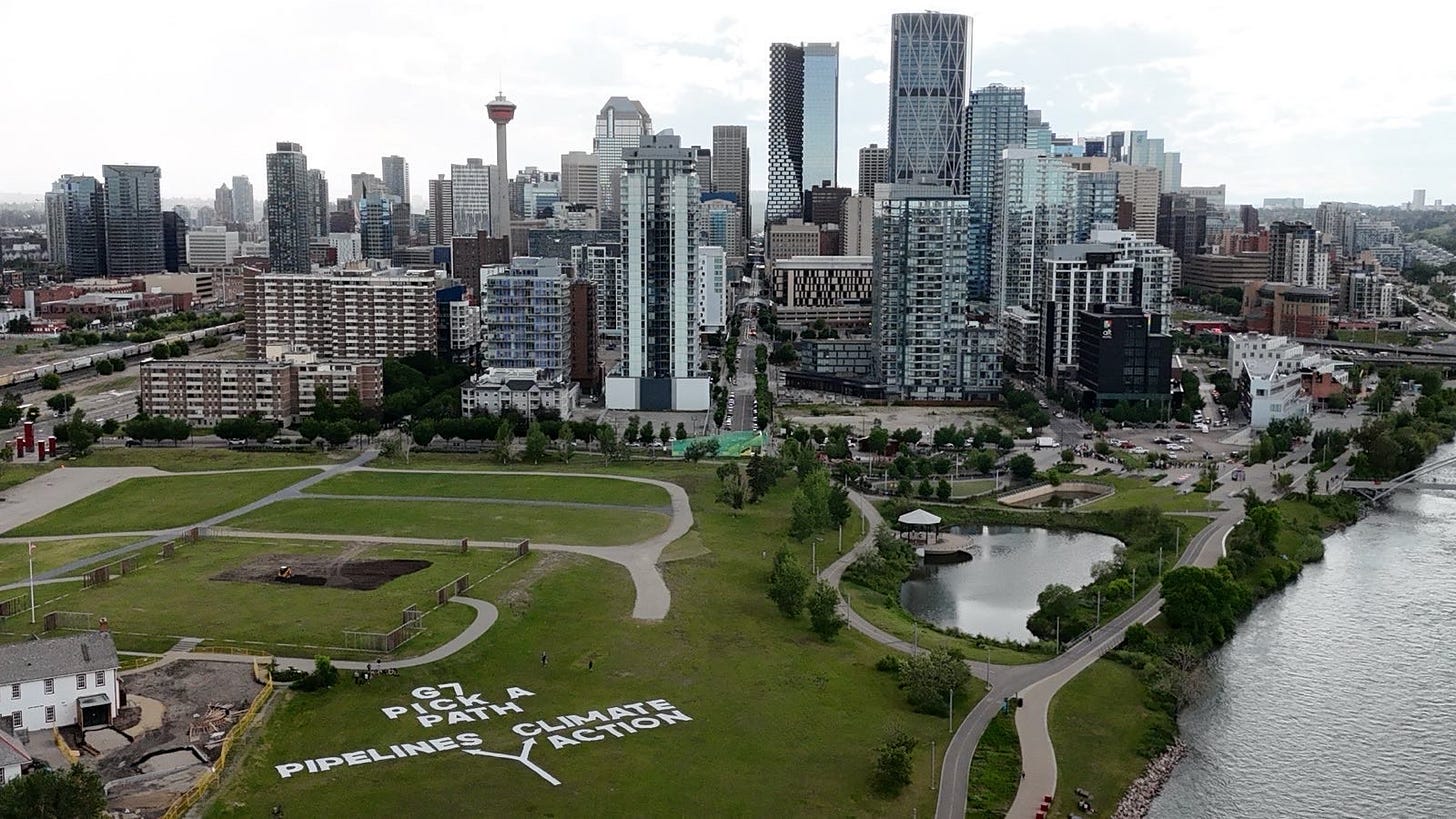
This was based on a similar installation installed in Ottawa after Carney was re-elected, which told the prime minister to pick the path.
Prime Minister Mark Carney, who has already introduced legislation that will make it quicker and easier to build fossil fuel infrastructure, appears to have made his choice. But even if Carney cannot be swayed, it’s worth reminding the broader public that there is an alternative.
On the same day, the International League of Peoples’ Struggle (ILPS) held a “people’s forum” to offer more alternatives to the priorities of the leaders about to gather in Kananaskis.
A key question that was raised at the forum, which was a theme throughout the weekend’s protest, was how to draw together a cohesive movement from the various issues being protested and sustain it after the G7 circus leaves town.
"The G7, it's happening for a few days, but it's going to wrap up and leave," Yasmeen Khan of the ILPS told CBC News.
"But the issues are still going to be there. So how do we, in Calgary and in Alberta particularly, build a people's movement?"
I arrived at city hall a bit early on Sunday for a noon protest in support Indigenous water rights, dubbed Hands Off Our Water, followed by a march against Western imperialism and the Gaza genocide organized by the ILPS.
I caught the tail-end of two concurrent protests. The first, occurring on the north side of the plaza was in support of Kashmir, which faces triple occupation by India, Pakistan and China. The other, on the plaza’s south side, drew attention to Ethiopia’s mass murder and forced displacement of the Amhara people.
There were people in keffiyehs gathering, Trots hawking newspapers and an eclectic array of signs—Canada Is Burning; Wind! Solar! No Coal; Israel Murdered 15 Medics in Cold Blood; Stop the Genocide in the Congo; and LandBack.
Rick Bell of the Calgary Sun, who spent a portion of the afternoon asking people in keffiyehs to disavow Hamas, said there were Maoists in attendance, but colour me skeptical of his ability to distinguish a Maoist from a Trot.
I would estimate that between the rally and march, there was somewhere in the realm of 1,000 people in attendance, which Bell noted was substantially smaller than Calgary protests when the G8 was held in Kananaskis in 2002.
What the Dinger didn’t note was that the protests 23 years ago occurred at the height of the anti-globalization movement, with demonstrators flying in from all over the world in an age before the deleterious climate impact of flight was as well known.
In this case, the only major contingent from outside Calgary was some protestors who bussed and carpooled down from Edmonton.
While the protest was centred on Indigenous water rights, the lineup included people from the climate, migrant rights, Palestinian liberation and Amhara justice movements.
The first speaker was Josie Auger, a Keepers of the Water board member from Bigstone Cree Nation in Treaty 8.
The Bigstone community of Lake Chipewyan had to evacuate in late May due to wildfires, which are becoming an increasingly frequent occurrence due to the climate crisis.
The G7 is an opportunity to remind world leaders that water scarcity is a global issue, said Auger.
“Our spirituality is connected to the sun, to the earth, to the water, and to the air we breathe, and so we remember these things, and we remember that we never gave up our rights to the water,” she added.
Calgary Climate Hub executive director Jared Blustein emphasized the conspicuous absence from the G7 agenda of climate change, income inequality and Indigenous self-determination “in any meaningful form.”
“This is even more troubling within our current social and economic context,” Blustein added.
“For too many years now, our lives, our families and our world have been increasingly economized. Today, a hyper form of capitalism threatens our collective future for the wealth and power of a few, often supported by the policies and actions of the varied nations meeting today in Kananaskis.”
Isa Carlin of Migrante Alberta aptly tied together the plight of Filipino migrant workers, the ecological crisis and imperialism.
The land in the Philippines is fertile, rich and plentiful, but it is owned by the political dynasty landlord families who serve the interests of foreign imperialists, including Canada, including the G7 governments.
These families exploit the land and transform our beautiful homeland into haciendas, or plantations, where we grow crops for export while farm workers and peasant farmers can barely afford rice.
Solving the problem of land ownership and land stewardship in our homeland is our greatest contribution, and it is our internationalist duty, so that we end the system of forced migration, which brings us to Turtle Island in a spirit of international solidarity.
Blackfoot activist Nicole Johnson said to great applause that she’s “tired of the First Nations being put on the back burner.”
“No more,” said Johnson.
Referencing a video (shot by yours truly) of Premier Danielle Smith asking protestors in Fort Macleod for “courtesy” as she excused her government’s plans to mine the eastern slopes of the Rocky Mountains for coal, Johnson praised the demonstrators.
“Courtesy is not what she got. Despite the lies that were put out there, the people spoke, and I was so happy the people were loud and clear,” said Johnson.
Blackfoot Elder Charlotte Yellowhorn McLeod emphasized the universal nature of the struggle for Indigenous water rights, “because when we stand up for our water, it isn't just to drink water for Indigenous people, it's for you.”
“I’m really gratified to see all nations [are] here,” she added. “The only voice we're going to have is when we support each other.”
She explicitly connected the horrific images coming out of Gaza to the history of Indigenous Peoples in Canada.
“The Israelis are shooting at people, families and children, and it's a shameful thing. It hurts my heart to see that in the news,” Yellowhorn McLeod said. “And you know what? That happened to our Indigenous people in this country. We are still under genocide.”
And then we marched, with a heavy emphasis on the dire situation in Palestine.
The cops boasted to the Canadian Press in May that hosting the G7 is “the largest domestic security operation" conceivable, and they certainly acted like it.
There were hundreds of Calgary Police Service (CPS) officers decked out in riot—err, tactical—gear along the perimeter of the march route, which began north along Macleod Trail before turning west on 6th Avenue S.E.
At that intersection, somebody pelted protestors with eggs from a rooftop.
The cops, who were snapping photos of protestors throughout the march, didn’t seem too interested in finding out who did that.
The chants at the march would be familiar to anyone who’s attended a Palestine solidarity protest over the past two years—free free Palestine; from the river to the sea, Palestine will be free; CPS, KKK, IOF, they’re all the same; Carney, Carney, you can’t hide, we charge you with genocide.
The original plan was to march along Stephen Avenue, but police blocked the protestors from accessing the pedestrian street, forcing them back along to city hall.
Once we returned to city hall, one of the march leaders announced on their megaphone that the cops had stopped blocking Stephen Avenue, and so we marched back.
As we made our way along Stephen, I spotted a couple Israeli and American flags visible in the distance.
I thought it might have been some organized counter-protest of the sort that Palestine solidarity demonstrations in Calgary have regularly encountered over the past two years.
Taking off my keffiyeh and stuffing it in my back pocket to check out the other protest, I realized it was just a bunch of Jesus freaks. I spotted notorious local hate preacher and convicted criminal Artur Pawlawski near the front of their march.
One protestor was shouting Jesus! repeatedly at the top of their lungs, and another person wearing a portable voice amplifier said in response to our chants: “Only Jesus can free Palestine.”
As the two groups approached each other, the cops got between us, pushing the far larger anti-G7 march back while shouting move in unison to allow the relatively small band of Jesus freaks to turn at the intersection.
There was, to my knowledge, no arrests or violence, but the sheer size of the police presence added to the dystopian vibe of the DDZ.
The next day, I hitched a ride to Banff with Dr. Joe Vipond of Calgary Climate Hub, who was giving a speech at a climate rally in the closest DDZ to the summit.
That event was much smaller than the one in Calgary the day before, attracting dozens rather than hundreds of attendees.
As was the case with the previous day’s event, the Banff protest wasn’t confined strictly to the topic at hand, with supporters of Ukraine and Palestine speaking alongside Indigenous and climate activists.
Event organizer Scott Diehl astutely threaded the needle between war and climate catastrophe in an interview before the event, noting that we’re living in an age of “polycrisis.”
“Let's remember every time that a bullet is fired and every time that a bomb is dropped, it adds to the greenhouse gas emissions. Not only is it a terrible human tragedy, but it's a terrible planetary tragedy,” said Diehl.
When we arrived at the parking lot of the Fenlands Banff Recreation Centre, there were Falun Gong protestors already gathered outside the building.
It’s hard to imagine why the ultraconservative anti-Communist cult, which adheres to the obscure spiritual practice of Falun Dafa, would be protesting the G7. China wasn’t invited to the summit and the Falun Gong-owned propaganda rag, the Epoch Times, loves Donald Trump and fossil fuels.
A well-intentioned organizer, certainly unaware of Falun Gong’s backstory, permitted a couple of the cult members to speak near the end of the event, with one proceeding to blame the riots in Los Angeles on Chinese subversion in front of a confused audience.
The imagery of a Falun Gong member raving about the evils of international Communism behind a LandBack banner was quite the sight to beholden.
I originally found the presence of Ukrainian protestors at an anti-G7 event somewhat confounding.
Ukrainian president Volodymyr Zelenskyy was invited to the summit; Russian president Vladimir Putin was not. But at the same time, Trump has indicated a shift away from U.S. support for Ukraine, and suggested he wants to reconstitute the G8 by bringing Russia back into the fold, which Ukrainians likely aren’t too thrilled about.
While there are superficial similarities between the situations in Ukraine and Palestine—namely, Russia’s occupation of parts of Ukraine and Israel’s occupation of all of historic Palestine—the way Ukraine has received billions of dollars in military aid from G7 countries has far more in common with Israel.
This point was illustrated when a person wrapped in an Israeli flag showed up alongside people draped in Ukrainian flags.
The pro-Israel attendee packed up his flag and left pretty early into the event, likely frightened by the presence of a small but mighty group of local Banff Palestine solidarity activists.
A Ukrainian-Canadian named Olga was the event’s first speaker, who framed Russia’s invasion of Ukraine as an “ecocide.”
Noting that the protest was occurring in a national park, she pointed to Russia’s devastation of the Askania-Nova nature reserve located north of Crimea, and likened Russia’s abduction of Russian-speaking Ukrainian children to Canada’s forced assimilation of Indigenous children.
Regardless of what you think of the origins of the war in Ukraine, and to what extent NATO expansionism provoked the Russian invasion, it’s undeniable that Ukrainian people are suffering greatly.
Speaking on behalf of ILPS, Shivanga Misra began by noting the “lip service” G7 leaders have played towards climate action before contrasting their words with the harsh reality:
As we stand here a few kilometers away from us, the leaders of the richest countries in the world are meeting in one of the most expensive resorts, surrounded by the Canadian Armed Forces and the RCMP, underwritten by hundreds of millions of dollars of public money.
Do you think that they've spent all this money, deployed their militarized police in order to help them fight climate change? No. There is no fighting climate change without Indigenous national liberation.
It is an imperialist colonial system that degrades and exploits the environment and those militarized police we have been seeing this whole weekend, those that are keeping the G7 leading politicians sheltered from the people, they are the same armed police who are forcing Indigenous land defenders off their lands, terrorizing and arresting people in order to make sure that the pipelines get built.
At the outset of his remarks, Dr. Vipond emphasized that he has “no illusions” that any of the G7 leaders are “listening to me or even care what I have to say.”
Vipond said he naively believed that
as the increasingly evident signs of climate collapse surrounded us, as the forests burned and the rivers rose and the climate dismounted, we would, as a prescient species focused on self-preservation, start to have more aggressive climate action, rather than capitulating to the heat, but we are being aggressively manipulated through propaganda and outmaneuvered.
Striking a more hopeful tone, he noted that “there are hundreds of billionaires, but there are billions of us.”
“If we want to be in the rooms, be at the negotiations, we need to rethink what we are doing. The marches and speeches are good, don't get me wrong, but we need more, louder marches and speeches,” said Vipond.
“We also need to do more organizing, more planning, more networking, more community and more love. So we're going to disperse today and go our various ways, but we need to gather together again soon and figure this out.”
Nigel Robinson, Keepers of the Water’s community engagement coordinator, spoke of a need to combat the “active devolution of our species” by “coming together and sharing ideas and figuring out how we can do things a little bit better.”
Robinson, who’s from Cold Lake First Nations in northeastern Alberta, said that colonial powers wanted to “disempower indigenous people, take our land take our culture,” because “they knew that our culture contained a lot of power, and our culture was not based off of greed and genocide.”
Robinson, with whom I spoke at a Watershed Sentinel-hosted webinar about the carbon capture, utilization and storage scam, slammed Carney for promoting this “greenwashing false solution.”
“There is more than enough extraction. The oil and gas industries do not need to be expanded,” he added, criticizing the release of tailings sludge into the Athabasca River and the province’s efforts to mine the eastern slopes for coal.
Humanity must “evolve a lot faster if we're going to stick around,” said Robinson.
“Because the planet is going to be okay. I can assure you of that. But human beings, and not just human beings, the animals that also live in the environments that we live in, they will all die out. We owe animals, we owe plants, we owe them a future too.”



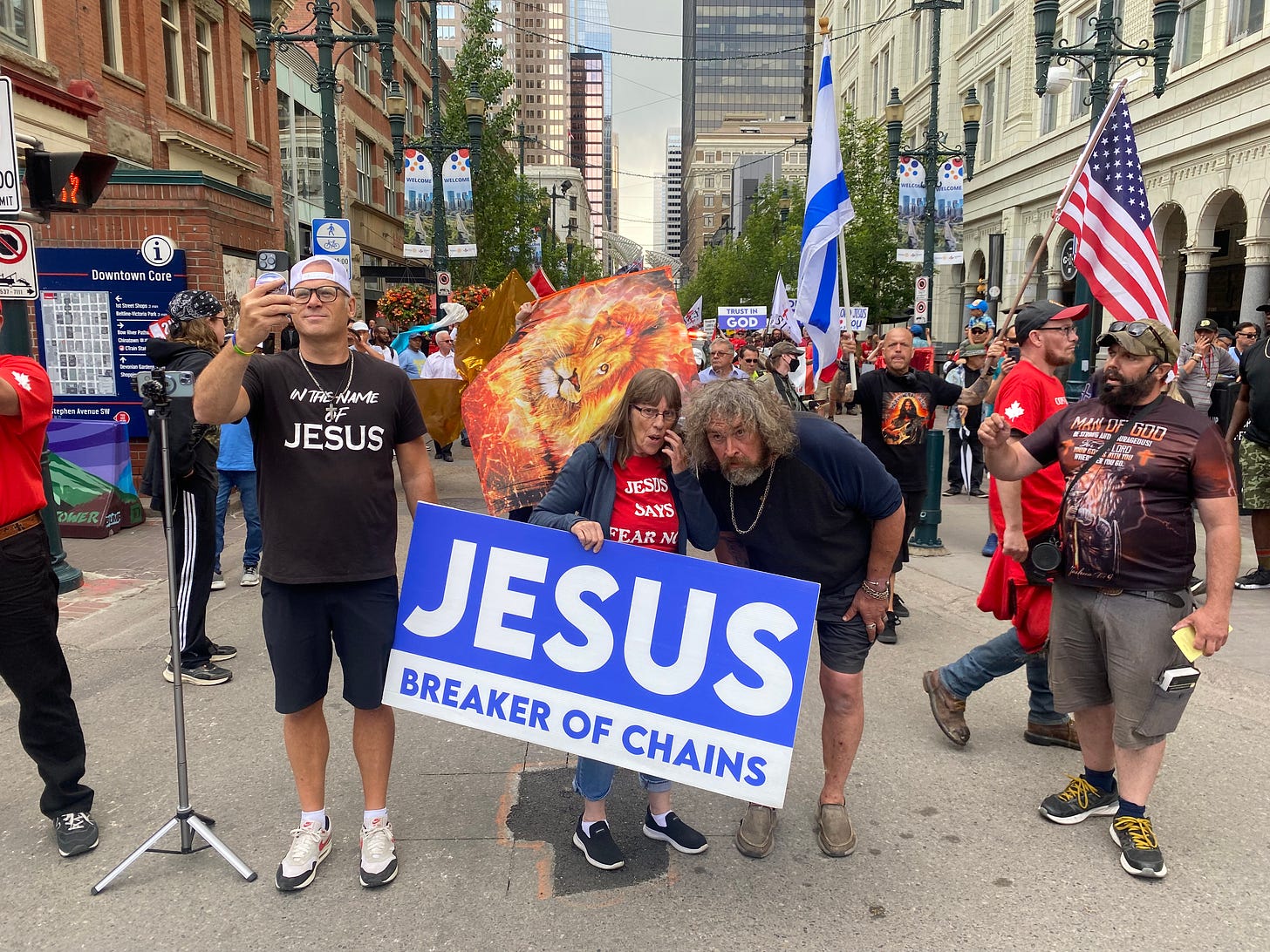
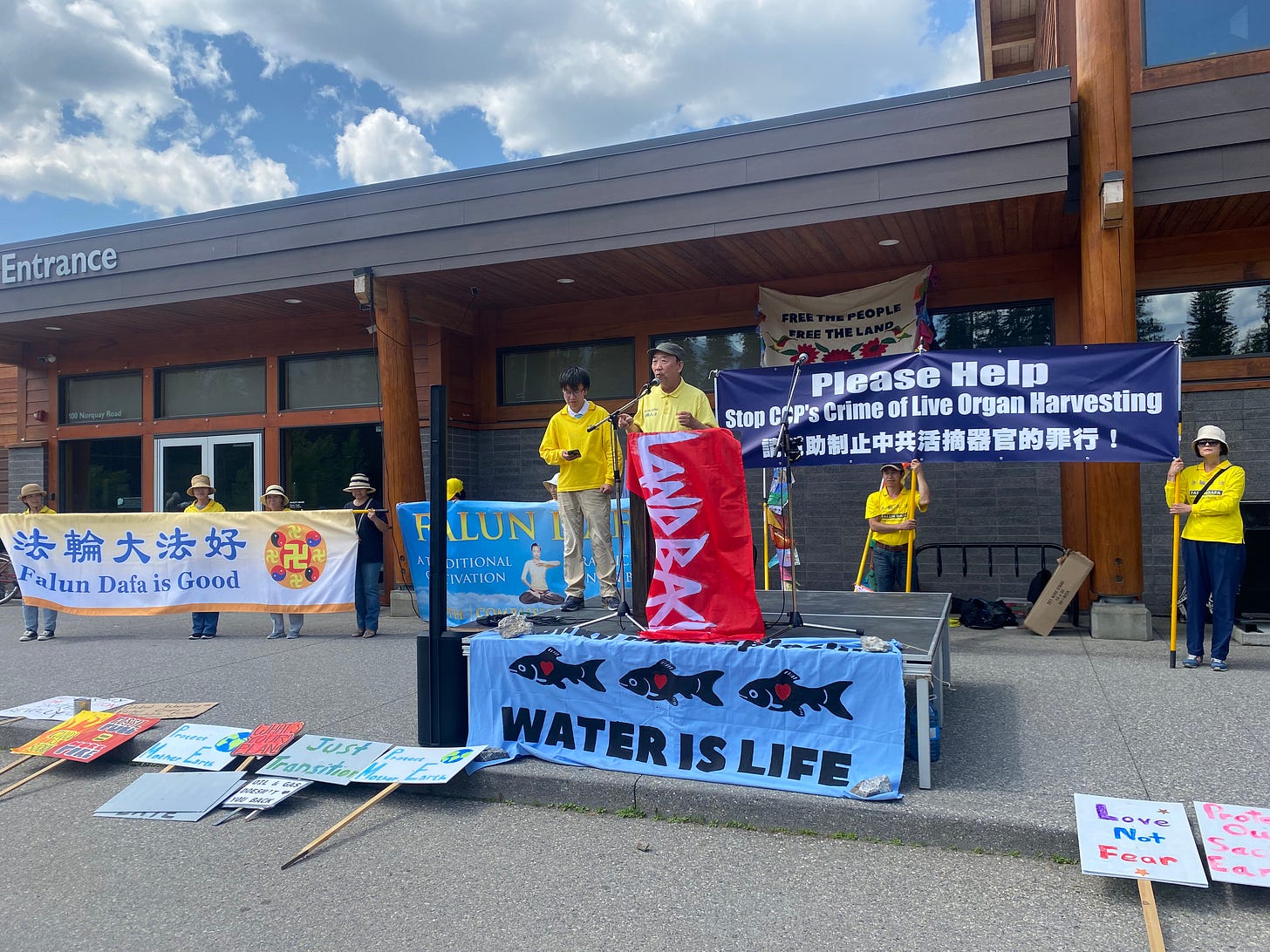
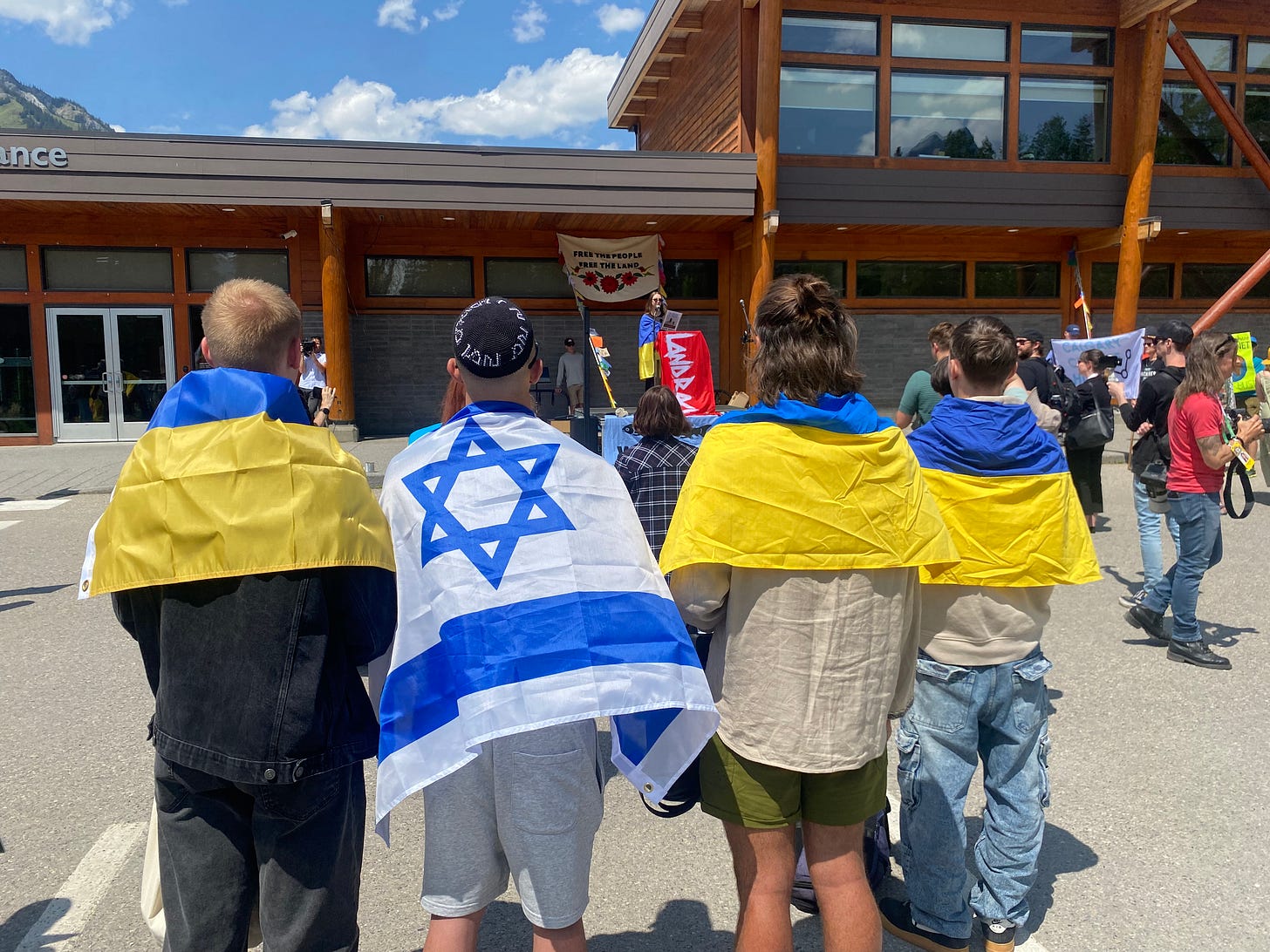
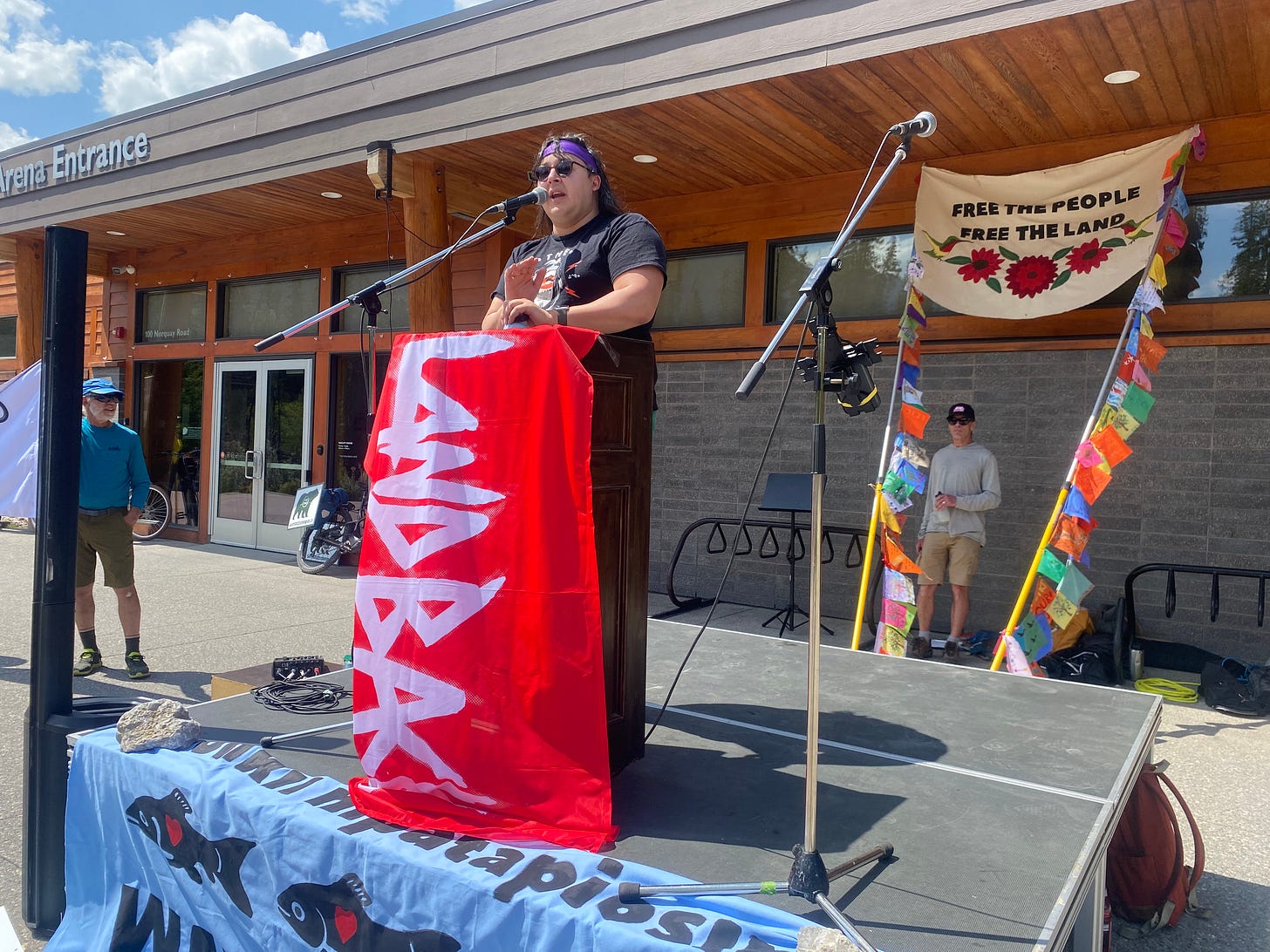
Thank you, I really needed this after Rick Bell. I am glad to know that protest is as complicated and messy and diverse and ridiculed as ever. The enemy of the revolution is not repression; it is indifference and ignorance. Viva el periodismo!